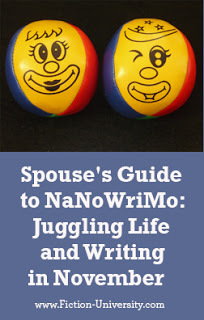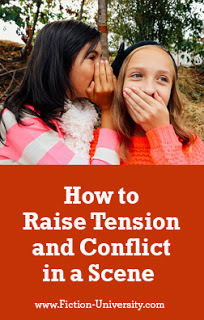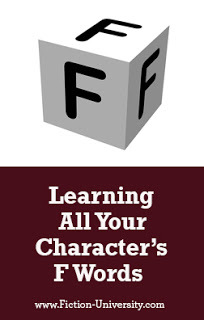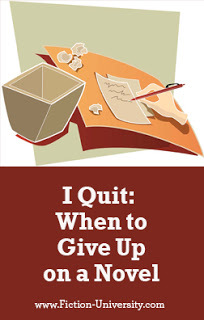Janice Hardy's Blog, page 91
November 5, 2018
10 Questions to Ask When Choosing a Setting
 By Janice Hardy, @Janice_Hardy
By Janice Hardy, @Janice_Hardy I'm deep into NaNo this month on a new book, so here's a dip into the archives for one of my favorites. Enjoy!
Some writers craft meticulous settings and build an amazing worlds, while others use the minimal details to suggest a place. But no matter what kind of story you write, it takes place somewhere. Maybe it's a small room, a town, or even a galaxy. What's more, setting can be a backdrop or a character in the novel. It's versatile!
But what if you're not sure where to set your novel? Then here are a few questions you can ask to find the right setting for your story:
1. Where are your favorite places?
If you’ve always loved a particular location, that passion will spill over into your novel’s setting. A favorite city could be the perfect place for your characters to live. If there’s no specific place, something more general like the beach or the mountains could work as well.
Continue ReadingWritten by Janice Hardy. Fiction-University.com

Published on November 05, 2018 03:04
November 4, 2018
Writing Prompt: The Photo Prompt: Because It's There
By Janice Hardy, @Janice_Hardy
This week’s prompt is a photo prompt. Write whatever comes to mind, be it a description, a story, or even a poem.
Write something inspired by this photo.
Written by Janice Hardy. Fiction-University.com
This week’s prompt is a photo prompt. Write whatever comes to mind, be it a description, a story, or even a poem.
Write something inspired by this photo.

Written by Janice Hardy. Fiction-University.com

Published on November 04, 2018 03:50
November 3, 2018
Real Life Diagnostics: Does the Dialogue Sound Natural and Believable?
 Critique By Maria D'Marco
Critique By Maria D'Marco Real Life Diagnostics is a weekly column that studies a snippet of a work in progress for specific issues. Readers are encouraged to send in work with questions, and we diagnose it on the site. It’s part critique, part example, and designed to help the submitter as well as anyone else having a similar problem.
If you're interested in submitting to Real Life Diagnostics, please check out these guidelines.
Submissions currently in the queue: Two
Please Note: As of today, RLD slots are booked through November 17.
This week’s questions:
1. Does the dialogue sound natural and believable?
2. Is there enough information to indicate that escalating problems with his boss could be the external conflict and future questioning of his non-belief in alien abductions could be his internal conflict? Or is it too soon in the story?
3. Would you keep reading?
Market/Genre: Unspecified
On to the diagnosis…
Continue ReadingWritten by Janice Hardy. Fiction-University.com

Published on November 03, 2018 05:37
November 2, 2018
The Spouse's Guide to NaNoWriMo: Juggling Life and Writing in November
 By Thomas Hardy
By Thomas HardyAh, November. The thrill of Halloween is fading. A chill is in the air. Autumn leaves are putting on their best displays of the year. Pumpkin spice is in the air. And every write I know is suddenly offline, uncommunicative and hard to find.
Yes folks, it’s NaNo time. National Novel Writing Month is here and the Starbucks gatherings sound like a herd of mice in tap shoes.
I’m married to an author. NaNo has been part of our holiday cycle for a lot of years now. It’s a period where she is doing her best to focus and make it the most productive 30 days of the year. That takes a big commitment from her and as hard as it is, it can be just as tough on a spouse. So here are a few thoughts to help you get through it together.
Continue ReadingWritten by Janice Hardy. Fiction-University.com

Published on November 02, 2018 04:05
November 1, 2018
The Indie Publisher’s Toolbox – Part 3: Social Media
 By Ray Flynt
By Ray FlyntPart of the Indie Author Series
Thus far we’ve examined an author’s website, blogs, and an author’s newsletter.
The toolbox analogy is apt because, although you may think of yourself as a writer, you still need to build your audience. To be cliché, “Rome wasn’t built in a day” and neither will you reach your full sales potential overnight. It’s a process. At times, it may seem like two steps forward and one backward.
My first published book (before becoming an indie author) was a hardcover priced at $25.95. I joked that you couldn’t get relatives to pay that much for a book. Readers who willingly shell out nearly $30 for the latest Danielle Steele or James Patterson, might be less likely to take a chance on an unknown author.
Continue ReadingWritten by Janice Hardy. Fiction-University.com

Published on November 01, 2018 05:11
October 31, 2018
Shh! It's a Secret: How to Raise Tension and Conflict in a Scene
 By Janice Hardy, @Janice_Hardy
By Janice Hardy, @Janice_Hardy Tension is a valuable tool for getting readers to turn the page--no matter what genre you write in. Here's an updated look at a great tip for creating tension.
Conflict and tension are two things writers want in every scene, but it can be rough getting them both in there without a fight. Characters can't always be at odds or butting heads, and "conflict as a fight" gets old pretty fast. Even a solid difference of opinion can only happen so many times before it starts to feel repetitious.
It's also tough to find new ways to build tension when the characters in the scene are friends working toward the same goal. How do you create conflict and not have friends turn on each other?
Continue ReadingWritten by Janice Hardy. Fiction-University.com

Published on October 31, 2018 03:00
October 30, 2018
8 Ways to Create Character Flaws: Learn All Your Character’s F Words
 By Bonnie Randall
By Bonnie Randall Part of the How They Do It Series (Contributing Author)
A double shot of Bonnie's wisdom this month--here's another peek at creating solid character flaws.
In my counseling practice, the following F Words are actually called Major Life Areas, but if I say MLAs I either sound jargon-y or like I’m using some sort of strange sports acronym. So let’s stick with F Words (which comes with the added bonus of appeasing the not-so-secret part of me that likes to swear).
When examining a person’s Major Life Areas, we determine their level of function, their level of dysfunction, what they value in life and why. A person’s “F Words” reveal their flaws and lay bare their strengths. In fiction, just like in real life, your character’s F Words will show you how he or she thrives in some areas while struggling in others. Some of his/her Major Life Areas will be over-developed compensators for others that are woefully impoverished and painful for him or her. Difficulty in Major Life Areas reflect both inner and outer conflict—which, in fiction, is gold.
Continue ReadingWritten by Janice Hardy. Fiction-University.com

Published on October 30, 2018 03:00
October 29, 2018
I Quit: When to Give Up on a Novel
 By Janice Hardy, @Janice_Hardy
By Janice Hardy, @Janice_Hardy When it is time to call it quits with your manuscript?
Unless you're one of the rare lucky ones to sell the first book you ever wrote, you'll have that moment when you wonder if it's time to shove your baby in the trunk. I've had those thoughts twice with just one manuscript, and I re-wrote and re-submitted my first novel. The first time I decided it wasn't time to give up and slaved away another year. The second time, I knew it was over.
How?
Well, 50 rejections made it pretty clear that the novel had problems, but what really convinced me was the nagging feeling I'd had that the book wasn't bad, but it wasn't great either. Good wasn't going to cut it and get me published. It was hard to admit that I had a decently written novel with an overdone plot. But I knew. Oh, I knew.
Continue ReadingWritten by Janice Hardy. Fiction-University.com

Published on October 29, 2018 03:00
October 28, 2018
Writing Prompt: The Free Write: Nice...Costume?
By Janice Hardy, @Janice_Hardy
This week’s prompt is a free write, so take the seed below and run with it. It doesn’t have to turn into anything (unless you want it to, of course), just let the words flow and see where they go.
Write something using this situation as inspiration:

On Halloween night, you’re handing out candy at the door. But one of the trick or treaters’ costumes looks a little too real.
Write as much or as little as you’d like. Written by Janice Hardy. Fiction-University.com
This week’s prompt is a free write, so take the seed below and run with it. It doesn’t have to turn into anything (unless you want it to, of course), just let the words flow and see where they go.
Write something using this situation as inspiration:

On Halloween night, you’re handing out candy at the door. But one of the trick or treaters’ costumes looks a little too real.
Write as much or as little as you’d like. Written by Janice Hardy. Fiction-University.com

Published on October 28, 2018 05:38
October 27, 2018
Real Life Diagnostics: Would You Ask for the Full Manuscript After Reading this Query?
 Critique By Janice Hardy, @Janice_Hardy
Critique By Janice Hardy, @Janice_HardyReal Life Diagnostics is a weekly column that studies a snippet of a work in progress for specific issues. Readers are encouraged to send in work with questions, and we diagnose it on the site. It’s part critique, part example, and designed to help the submitter as well as anyone else having a similar problem.
If you're interested in submitting to Real Life Diagnostics, please check out these guidelines.
Submissions currently in the queue: Three
Please Note: As of today, RLD slots are booked through November 17.
This week’s question:
1. Would you ask for the full manuscript after reading this query?
Market/Genre: Young Adult Fantasy
On to the diagnosis…
Continue ReadingWritten by Janice Hardy. Fiction-University.com

Published on October 27, 2018 05:33



